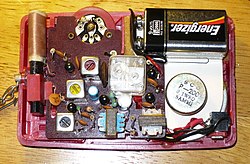
Back مستقبل تغاير فوقي Arabic Суперхетеродинен радиоприемник Bulgarian Receptor superheterodí Catalan Superheterodyn Czech Superheterodynmodtager Danish Überlagerungsempfänger German Receptor superheterodino Spanish Superheterodüünvastuvõtja Estonian گیرنده سوپرهترودین Persian Récepteur superhétérodyne French


A superheterodyne receiver, often shortened to superhet, is a type of radio receiver that uses frequency mixing to convert a received signal to a fixed intermediate frequency (IF) which can be more conveniently processed than the original carrier frequency. It was invented by French radio engineer and radio manufacturer Lucien Lévy.[1][unreliable source?] Virtually all modern radio receivers use the superheterodyne principle.